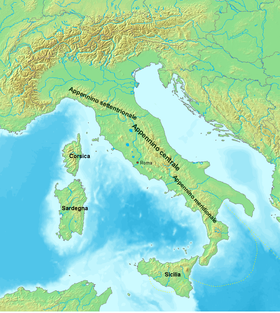Ligurian Appennines
| Apennine Mountains | |
|---|---|
| Monti Appennini | |

Mt. Pollino inside the Pollino National Park, Calabria
|
|
| Highest point | |
| Peak | Corno Grande (Big Horn) |
| Elevation | 2,912 m (9,554 ft) |
| Coordinates | 42°28′9″N 13°33′57″E / 42.46917°N 13.56583°E |
| Dimensions | |
| Length | 1,200 km (750 mi) northwest to southeast |
| Width | 250 km (160 mi) southwest to northeast |
| Geography | |
| Countries | Italy and San Marino |
| Range coordinates | 43°16.9′N 12°34.9′E / 43.2817°N 12.5817°ECoordinates: 43°16.9′N 12°34.9′E / 43.2817°N 12.5817°E |
| Geology | |
| Age of rock | Mesozoic for formation of rock, Neogene-Quaternary for orogeny |
| Type of rock | Apennine fold and thrust belt |
The Apennines or Apennine Mountains (/ˈæpənaɪn/; Greek: Ἀπέννινα ὄρη; Latin: Appenninus or Apenninus Mons—a singular used in the plural; Italian: Appennini [appenˈniːni]) are a mountain range consisting of parallel smaller chains extending c. 1,200 km (750 mi) along the length of peninsular Italy. In the northwest they join with the Ligurian Alps at Altare. In the southwest they end at Reggio di Calabria, the coastal city at the tip of the peninsula. Since the year 2000 the Environment Ministry of Italy, following the recommendations of the Apennines Park of Europe Project, has been defining the Apennines System to include the mountains of north Sicily, for a total distance of 1,500 kilometres (930 mi). The system forms an arc enclosing the east side of the Ligurian and Tyrrhenian Seas.
The etymology most frequently repeated, because of its semantic appropriateness, is that it derives from the Celtic Penn, "mountain, summit":A-penn-inus, which could have been assigned during the Celtic domination of north Italy in the 4th century BC or before. The name originally applied to the north Apennines. However, historical linguists have never found a derivation with which they are universally comfortable. Wilhelm Deecke said:"...its etymology is doubtful but some derive it from the Ligurian-Celtish Pen or Ben, which means mountain peak."
...
Wikipedia

